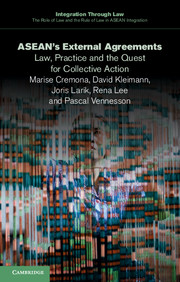Book contents
- Frontmatter
- Contents
- List of tables
- List of charts
- General editors' preface
- 1 Introduction
- 2 The legal and institutional framework for ASEAN external agreements: the centrality of ASEAN
- 3 An inventory and typology of ASEAN external instruments: overview and trends
- 4 ASEAN as a contracting party
- 5 Beyond market access? The anatomy of ASEAN's preferential trade agreements
- 6 A regional strategy: a typology of ASEAN partnership and co-operation agreements
- 7 Between great-power rivalries and supranationality: ASEAN external instruments and regional hedging strategies
- Executive summary
- Appendices
- Index
3 - An inventory and typology of ASEAN external instruments: overview and trends
Published online by Cambridge University Press: 05 May 2015
- Frontmatter
- Contents
- List of tables
- List of charts
- General editors' preface
- 1 Introduction
- 2 The legal and institutional framework for ASEAN external agreements: the centrality of ASEAN
- 3 An inventory and typology of ASEAN external instruments: overview and trends
- 4 ASEAN as a contracting party
- 5 Beyond market access? The anatomy of ASEAN's preferential trade agreements
- 6 A regional strategy: a typology of ASEAN partnership and co-operation agreements
- 7 Between great-power rivalries and supranationality: ASEAN external instruments and regional hedging strategies
- Executive summary
- Appendices
- Index
Summary
Introduction
In this chapter we present an inventory and typology of ASEAN's external agreements, which will then form the basis of our analysis of ASEAN treaty-making practice in the following chapters. Our analysis is based on the inventories and tables which are included in the appendices and is founded on the type of instrument used and their legal quality, the parties to the instruments, and their content. A few initial comments on each of these are in order.
First, as to the type of instrument, we have included in our dataset not only legally binding international agreements (such as treaties) but also other instruments: memoranda of understanding (MoUs), action plans and declarations concluded between, or issued jointly by, ASEAN on the one side and a third state, group of states or international organisation on the other. Thus we exclude unilateral ASEAN instruments. The instruments vary widely in terms of length and significance, as well as legal quality. Our classification is based on the indicators of legal quality developed by Davinia Aziz for the purpose of analysing the typology of internal ASEAN instruments. Since a large number of ASEAN external instruments fall into the category of non-legally binding (102 out of a total of 175 instruments) inclusion of the latter will present a fuller picture of ASEAN external relations, will put the binding agreements into their broader institutional context, and will allow us to make an assessment as to whether legally binding commitments are preferred for different subject matters or for relations with different parties, and whether that choice alters over time. An analysis of the legal quality of ASEAN external instruments is presented in section 2 below.
Second, we have categorised the instruments in terms of content. We distinguish between (i) political and security, (ii) economic, (iii) social and cultural and (iv) partnership and co-operation instruments.
- Type
- Chapter
- Information
- ASEAN's External AgreementsLaw, Practice and the Quest for Collective Action, pp. 58 - 83Publisher: Cambridge University PressPrint publication year: 2015



